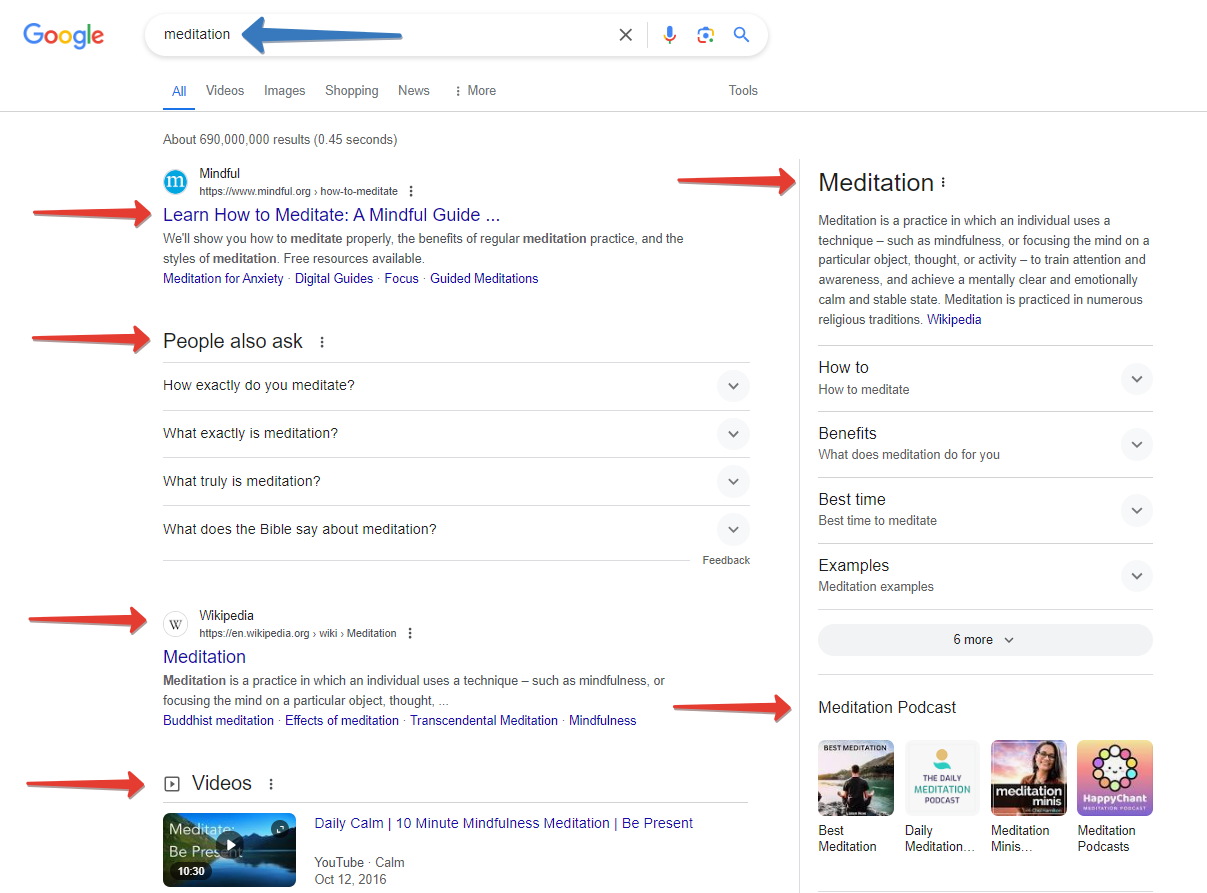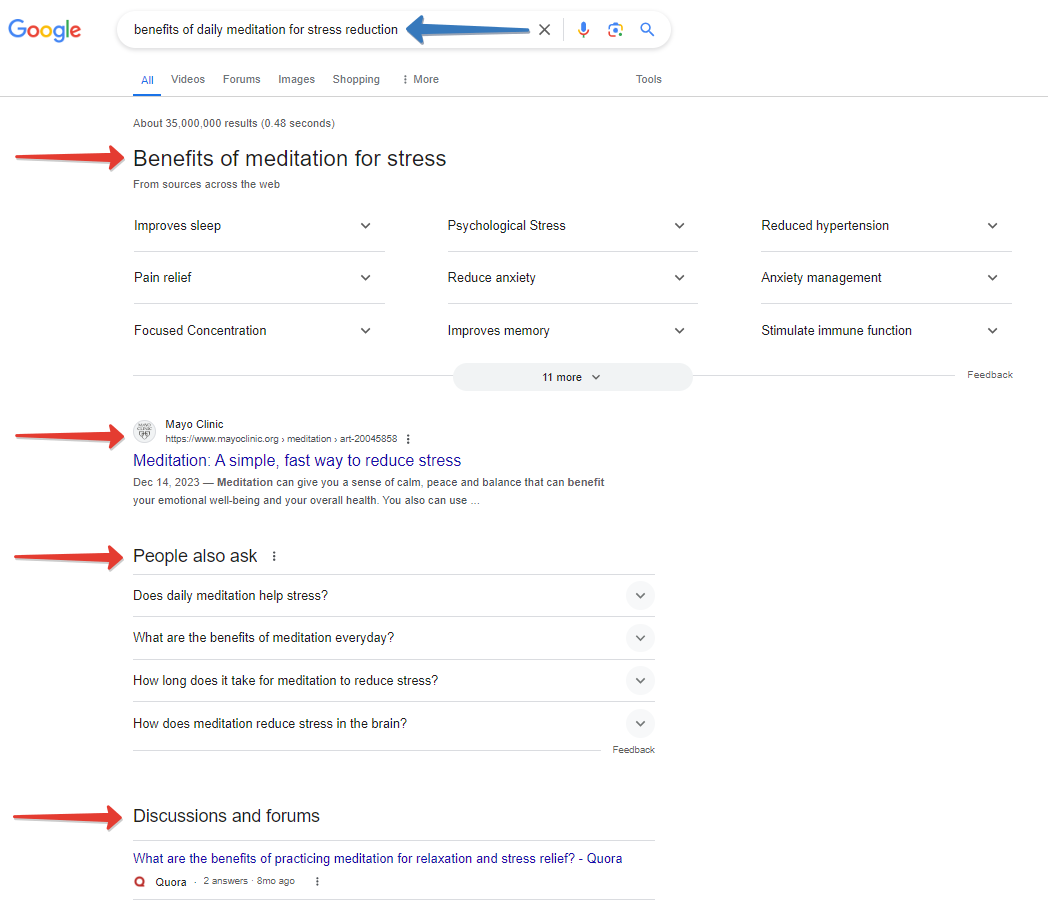Keywords are the basis of any effective SEO strategy. You should optimize your content for the right keywords to drive more organic traffic by targeting searches people are actually conducting on search engines like Google. But should you focus your efforts on long-tail or short-tail keywords? The answer is both.
Difference Between Long-Tail and Short-Tail Keywords
To play well with long-tail and short-tail keywords, you have to know the very basics of each type.
Short-Tail Keywords
Short-tail keywords are short, often single-word searches that have higher traffic volumes but more general intent. For example:
- meditation
- dog training
Common attributes of short-tail keywords include:
- 1-3 words in length
- Broad topics with variability in searcher intent
- Higher monthly search volume
- More competition due to wider appeal
Searches for “dog training” could mean anything from basic obedience to specialized skill training to correction of certain behaviors. The intent spectrum is wider. Similarly, “meditation” leaves more open to the interpretation of form, purpose, or specific benefits sought.

With less context to indicate precise user intent, short-tail keywords cast wider nets that drive more overall traffic volume but lower relevancy without further targeting.
Long-Tail Keywords
Conversely, long-tail keywords are longer, more specific multi-word phrases that users search for to find very precise information to match their query and intent.
For example:
- how to train your dog to stop barking
- benefits of daily meditation for stress reduction
Long-tail examples commonly:
- Contain 3-5 words
- Identify niche subsets under a broader topic
- Include more context to clarify the exact search intent
Because long-tail keywords offer more parameters, search volumes tend to be lower, but conversion rates are much higher for matching content. If someone searches “meditation benefits,” that could signify a range of interests. But “benefits of daily meditation for stress” shows clear intent that content meeting that specificity will better address the searcher’s needs.

How to Find the Best Short-Tail Keywords
Though less glamorous, identifying widely searched short-tails remains necessary for securing traffic scale. Here are the top tips for researching relevant short-tail targets.
Google Keyword Planner
Much like with long-tails, start short-tail research within Google’s Keyword Planner. Monthly searches and competition data gauge potential.
Autocomplete … Again
Check Google autocomplete again, but now note which single-word phrases trigger the most autocomplete suggestions. Higher volume indicators deserve shortlisting.
Industry Data
Explore credible data sources detailing search volumes by topic. Compile industry short-tail insights for assessing focus areas with demonstrated demand.
Site Search Analytics
Check search analytics from your website and tally short-tail queries. Score “quick wins” by optimizing existing pages matching visitor searches that could quickly amplify traffic.
Competitor Analysis
Conduct an analysis of competitors using SEO tools such as Ahrefs to identify which short-tail terms they rank for. Assess if reasonable to pursue the expansion opportunities where you could take share.
Tips for Selecting Effective Long-Tail Keywords
When researching long-tail contenders, here are key selection criteria to filter best bets:
- Search volume – What search volume do long-tail options drive? Set a monthly threshold like 500 or 1000 to focus on more worthwhile targets.
- Competition – Assess difficulty scores or Domain Authority metrics for current site ranking. Can less competitive long-tails deliver better ROI for focusing content optimization?
- Conversion potential – Given the searcher intent specificity, which long-tails show the highest potential to convert visitors into customers or email list sign-ups?
- Relevance – Stay aligned with your content pillars and topics. No sense in pursuing off-theme long-tails that won’t interest your audience.
- Trends – Prioritize rising long-tails experiencing a growth uptick over last year. Position early for surging searcher demand.
- Uniqueness – Are competitors targeting certain long-tails yet based on pages indexed for that phrase in Google? Stake first mover advantage where gaps exist.
Tips for Selecting Effective Short-Tail Keywords
As with long-tails, choosing the “right” short-tail targets involves filtering criteria. Things to look at when evaluating priority short-tail keywords:
- Volume – Confirm adequate search scale using Keyword Planner data. Set a suitable volume floor, like 10k monthly searches.
- Competition – Can you reasonably rank within the top 5-10 among current results? Avoid overcrowded short-tails fetching 100 million searches with all sites boasting 95+ Domain Authority.
- Conversion potential – Do searcher intents for given short-tails suggest commercial buyers? Or are hobbyists unlikely to purchase? Assess revenue potential.
- Relevance – Do short-tails align thematically to serve your audience’s interests? Stay on brand.
- Trends – Are any growing or declining dramatically over the past year? Ride waves early.
- Intent variety – Do searcher intents vary significantly? If too broad with ambiguity, subdivision into distinct long-tails may prove advantageous to better address needs.
- Priority – Which cover important sub-topics do you want visibility for? Flag 3-5 “pillar” short-tails essential for your strategy.
How to Find the Best Long-Tail Keywords
You should conduct long-tail keyword research to reveal hidden gems aligned to your content that may be less competitive while still claiming decent search volume. Here are the top techniques and tools to use.
Analyze Search Analytics
Review search analytics from Google or YouTube to identify longer keyword phrases driving traffic and engagement. Filter by landing page or popular uploads to see associated long-tail searches. It makes visible more niche opportunities related to existing content resonating with audiences. Trend growth for certain long-tail terms informs expansion decisions as well.
Keyword Planner
Google’s free Keyword Planner offers keyword discovery and exploration features, including suggested long-tail ideas related to seed keywords you input. Filter by average monthly searches for specifics exceeding whatever your threshold is. The Keyword Planner also provides search volume data to quantify opportunities.
UberSuggest
Ubersuggest by Neil Patel is a free long-tail keyword recommendation tool that lists related long-tail variants by number of searches. Input a core keyword like “meditation,” and Ubersuggest provides a comprehensive list of extended phrases with data including traffic and difficulty scores. High search volume and low-difficulty long-tails represent promising targets.
SEO Intelligence Tools
Robust SEO platforms like Ahrefs, Moz, and SEMrush all contain long-tail identification features like related keywords, and phrase matches to uncover more specific phrase opportunities. Most offer one-week free trials to test capabilities.
Autocomplete Search
Start typing potential keyword themes into Google’s search bar and pay attention when autocomplete options appear below. The suggested searches that fill in demonstrate actual searches people are conducting. Compile long-tail variants from autocomplete to get real long-tail examples that inform your targeting priorities.
Which is Better: Short-Tail or Long-Tail Keywords?
It brings up the common question – should your optimization efforts prioritize long-tail keywords over short-tail or vice versa? The answer is both warrant focus as part of an inclusive approach.
Benefits of Short-Tail Keywords
However, even if long-tails drive the site strategy bus, short-tails play an equally important role by:
- Volume and scale – Short-tails underpin the search volume engine fueling visibility. Big numbers matter for business impact.
- Topically vital – Certain short-tail pillars remain must-haves for establishing legitimacy around core focus areas. Think “fitness” for a gym or “software” for a SaaS company.
- Gateway searches – Short-tail matches introduce your brand to new visitors who may then utilize site search to find long-tail content for purchase consideration.
- Table stakes – Some commonly sought short-tail terms have grown extremely competitive. But keeping a few trophy targets within your strategy keeps your brand in the conversation.
Benefits of Long-Tail Keywords
Though monthly search volumes don’t rival short-tails, long-tail keywords come with distinctive upsides:
- Higher conversion rates – ultra-specific long-tail matches strongly suggest someone very interested in your exact offering if you rank. Expect more qualified traffic.
- Less competition – Longer and more precise phrases tend to have fewer competing pages targeting them. Easier to rank newer content without needing links or authority time to build.
- Informs topics – Long-tail demand patterns spotlight very specific topic subsets and questions people want answers for. This reveals content expansion opportunities.
- Extended reach – Adding long-tails accrues incremental value, capturing more niche searches. Short-tails grab the “head”… long-tails get the “tail.”
If budget or resources only allow focusing on one, most experts suggest prioritizing long-tails that attract engaged searchers despite a modest volume trade-off.
As you see, long-tail and short-tail approaches offer complementary strengths balancing volume, competition, and conversion factors to maximize organic search visibility.
How Short-Tail and Long-Tail Keywords Work Together
Rather than an either/or decision, savvy SEO requires understanding the interconnected roles short and long-tail keywords play collectively.
Short-Tails Drive Scale
As highlighted above, short-tail keywords account for the majority of searches. Without visibility for important head terms in your space, brands miss huge traffic potential.
Short-tails bring site visitors in the front door. Optimizing pillar topics positions you competitively within search results for the terms really “moving the needle.” Conversion rates on these may pale to long-tails, but the volume makes up the difference many times over.
Long-Tails Convert Visitors
Once on the site, new visitors often use internal search if they don’t immediately find what they want. Others navigate site content refined by long-tail themes matching their interest.
Either path sees visitors refine and extend interest via long-tail searches on the site. Aligning site content and navigation to long-tail subsets turns explorers into engaged learners and, more likely, buyers.
Working Together
This short-tail traffic and long-tail conversion flywheel fuels scalable growth. Securing visibility for competitive short tails brings site visitors searching for your important topics. Long-tail content organization and optimization then facilitate their deeper immersion to become customers.
Balancing short and long-tail visibility allows your brand to maximize both new visitor growth and on-site engagement for stickiness and conversions. Play to the unique strengths of each for a comprehensive approach.
FAQ
Still debating long-tail vs. short-tail in your mind? These answers to commonly asked questions should provide more direction.
Which is better, long-tail or short-tail keywords?
There is no universal “better” option. Generally, long-tail keywords see higher conversion rates but lower volumes, while short-tails drive more traffic but wider variability in searcher intent. Ultimately, you want a balanced, well-rounded keyword portfolio encompassing both long-tails and short-tails.
How do you choose long-tail keywords?
You should assess parameters like search volume, competition levels, conversion potential, and relevance to focus efforts only on the most viable long-tails. You also want to analyze your analytics for indicators around engaging long-tail queries.
Are long-tail keywords more competitive?
Actually, most long-tail keyword phrases demonstrate significantly less competition than short-tail searches. By having 3-5+ words, long-tail searches are more niche and unlikely to have as many existing pages crafted to deliberately target that precise phrase.
How do short-tail and long-tail keywords work together in SEO?
Short-tail and long-tail approaches bring complementary strengths that allow brands to maximize both new visitor growth (short-tail traffic at scale) and on-site engagement (long-tail fueling conversions).
How can I optimize my content for both short-tail and long-tail keywords?
You should craft overview content for high-value short-tail targets focused on informing and attracting visitors new to your brand. Add linked content extending specific short-tail pillars that incorporate relevant long-tails into titles and on-page copy. Include primary short-tails and long-tails in page titles, descriptions, and H2 headers to help search engines further match queries. Link related short and long-tail pages together for clear site information architecture and improved crawl efficiency for search engines.
Wrap-up
Keywords remain supremely influential for SEO visibility and driving qualified website traffic. An effective keyword approach requires a mixed portfolio capturing visibility for competitive short-tails to grab traffic share while matching long-tail searcher intent through conversion-focused content.





